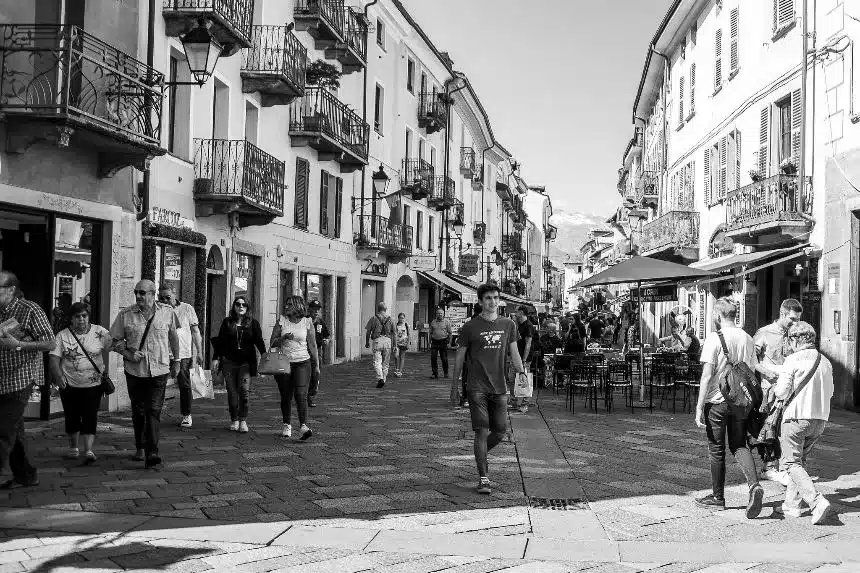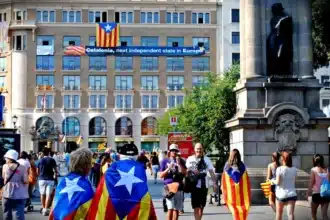The Significance of Linguistic Diversity
The year 2023 marked the 80th anniversary of the seminal ‘Declaration of the Representatives of Alpine Populations,’ a historically and culturally significant document for Italy’s Piedmont and Aosta Valley regions.
Born from the fervent anti-fascist resistance, this declaration was not merely a defiant stand against the oppressive regime of Mussolini but a visionary blueprint for a reimagined post-war Italy. It was a harbinger of change, proposing a federal and republican restructuring that would pivotally influence the nation’s trajectory.
At the core of this declaration lay a profound recognition of linguistic diversity as an integral element of cultural identity and political representation. It championed the rights of smaller nationalities and minority ethnic groups, foregrounding their needs in the realms of self-governance, language preservation, and education in native tongues. This emphasis was more than a political statement; it was a recognition of the rich tapestry of languages that have historically flourished across these Alpine regions.
It is imperative to continue advocating for policies and initiatives that support the vitality of minority languages.
The acknowledgment of linguistic diversity in this context was a radical departure from the prevailing ideologies of the time. It challenged the homogenizing forces of fascism that sought to suppress linguistic and cultural pluralism. By advocating for the protection and cultivation of minority languages and dialects, the declaration underscored the intrinsic value of linguistic variety as a cornerstone of democratic society and cultural vibrancy.
As this article unfolds, I will delve into the intricate dynamics of linguistic diversity within Piedmont and Aosta Valley, tracing its historical evolution, its socio-political ramifications, and the ongoing challenges and opportunities that this diversity presents. This exploration is not just an academic exercise; it is a journey into understanding how language shapes our identity, our politics, and our connections with one another in a world where diversity is both a heritage and a horizon to strive towards.
The Linguistic Landscape of Piedmont and Aosta Valley
The regions of Piedmont and the Aosta Valley, nestled at the crossroads of France and Italy, present a fascinating multilingual landscape, an intricate mosaic of languages and cultures. These areas are not just geographical entities; they are linguistic nexuses where Gallo-Romance languages — including Occitan and Franco-Provençal — flourish alongside Italian and French, the latter holding a significant place in the cultural and historical fabric of the regions. This rich linguistic plurality is more than a mere coexistence of tongues; it is a dynamic interplay of languages that has been shaped and reshaped by historical forces and contemporary policies.
Delving into the linguistic heritage of Piedmont, we find a region steeped in linguistic diversity. Its history is a testament to the confluence of Latin and Gallic elements, creating a unique linguistic identity. French, once dominant as a literary and cultural language, left an indelible mark on the region. Meanwhile, the vernacular Piedmontese, with its roots in the Gallo-Roman linguistic tradition, emerged as a significant language, coexisting with French and Italian. This linguistic tapestry of Piedmont reflects a deep-rooted diversity, a legacy of the region’s complex historical interactions.
The Napoleonic era brought about transformative shifts in the linguistic landscape of Piedmont. The French revolutionary occupation left a profound impact, integrating the region into the ambit of Jacobin France. This period was marked by significant linguistic developments, including the creation of a French-Piedmontese dictionary, which served as a symbolic representation of the region’s evolving linguistic identity. These events highlighted the intricate relationship between language and power, and how political changes can influence the linguistic dynamics of a region.
In understanding the linguistic landscape of Piedmont and the Aosta Valley, it is crucial to appreciate the historical depth and the socio-political forces that have shaped their linguistic identities. The story of these regions is not just about the languages spoken there; it’s about the people, the cultures, and the historical currents that have forged this diverse linguistic terrain. As we explore further, we see how this linguistic diversity has been both a source of cultural richness and a field of political contention, reflecting broader themes of identity, autonomy, and heritage in the heart of Europe.
The Post-Fascist Era and the Evolution of Linguistic Rights in Italy
In the aftermath of Mussolini’s dictatorship, the landscape of Italy’s political and cultural policies underwent a significant transformation, particularly concerning the recognition and preservation of linguistic diversity. This period marked a pivotal shift from the previous homogenizing tendencies to a more inclusive approach towards linguistic minorities.
A cornerstone in this transformation was the enactment of the 1948 Special Statute for the Aosta Valley. This legislation was a milestone in the institutional recognition of linguistic rights, formally acknowledging the use of French alongside Italian in the region. The statute represented not just a legal acknowledgment, but also a symbolic affirmation of the region’s unique cultural and linguistic heritage. It was a response to the region’s distinct linguistic identity, where French and other minority languages like Franco-Provençal had deep historical roots.
The state of linguistic minorities in the Aosta Valley and Piedmont poses significant challenges and questions for the future of linguistic diversity.
However, this progressive stride in the Aosta Valley stood in contrast to the situation in Piedmont. Despite Italy’s constitutional provisions that aimed to safeguard linguistic minorities, the journey towards effective recognition and protection of these languages in Piedmont was arduous and protracted. It was not until the adoption of Law 482 in 1999 that substantial progress was made in this regard. This law was a significant advancement in the recognition of the rights of communities speaking French, Franco-Provençal, and Occitan. It marked a recognition of the importance of preserving these languages as part of Italy’s cultural and linguistic mosaic.
Yet, the implementation of Law 482 also unveiled the complexities involved in defining and supporting linguistic minorities. The law’s application highlighted the challenges in balancing national linguistic policies with the specific needs of diverse linguistic communities. In Piedmont, the struggle for linguistic recognition was not just about achieving legal status for minority languages but also about fostering an environment where these languages could thrive and be actively used in daily life.
The post-fascist era in Italy, therefore, presents a nuanced narrative of progress and ongoing challenges in the realm of linguistic rights. The experiences of the Aosta Valley and Piedmont illustrate the diverse trajectories of linguistic communities in the face of changing political landscapes. These developments underscore the enduring importance of Linguistic Diversity as a key component of Italy’s cultural identity and the continuous need for policies that support and celebrate this diversity.
Current Challenges and the Future of Linguistic Diversity in Aosta Valley and Piedmont
In the contemporary context, the state of linguistic minorities in the Aosta Valley and Piedmont poses significant challenges and questions for the future of linguistic diversity. The vitality of these minority languages, essential threads in the cultural fabric of these regions, is a matter of ongoing concern.
In the Aosta Valley, while there have been commendable institutional efforts to preserve French, the situation of other minority languages, particularly Franco-Provençal, remains precarious. These efforts, though impactful, highlight the complexities involved in maintaining linguistic diversity in a modern context. The case of French in the Aosta Valley, contrasted with its decline in Piedmont, illustrates the varying effectiveness of linguistic policies and the need for region-specific strategies.
The struggle to preserve and recognize the rich tapestry of linguistic diversity in these regions is a crucial aspect of maintaining the pluralistic essence of society.
The situation of the Occitan language further illuminates the intricacies of preserving linguistic diversity. Influenced by regional movements and the varying degrees of recognition and support, the Occitan language’s journey reflects the broader challenges in safeguarding minority languages. It is a narrative that encompasses not just legal recognition but also the practical aspects of language use, education, and cultural integration.
A particularly poignant case is that of the Piedmontese language. Despite its rich history and unique linguistic characteristics, Piedmontese faces an uphill battle for formal recognition and revitalization. The absence of autonomous status for the region of Piedmont and the historically delayed acknowledgment of its linguistic minorities have led to significant shifts in minority identities and narratives. The quest for recognition of the Piedmontese language is not just about linguistic rights; it is also about affirming a cultural identity and heritage that has been long overshadowed.
These challenges, faced by linguistic minorities in both the Aosta Valley and Piedmont, underscore the delicate balance required in preserving linguistic diversity in the face of globalization, technological change, and shifting political landscapes. The future of these languages hinges not only on legal frameworks and institutional support but also on the engagement of the communities themselves and the broader society’s recognition of the value of this diversity. As we look forward, it becomes increasingly clear that the journey towards preserving linguistic diversity is as much about embracing the past as it is about innovating for the future.
Concluding Remarks: Linguistic Diversity at a Crossroads in Piedmont and Aosta Valley
As we reflect on the linguistic heritage of Piedmont and the Aosta Valley, it becomes evident that these regions stand at a pivotal crossroads in their linguistic history. The intricate interplay of historical events, political decisions, and social dynamics has woven a complex linguistic landscape, one that is rich in diversity but also fraught with challenges. This landscape is a testament to the resilience and adaptability of minority languages in the face of changing times and shifting paradigms.
The struggle to preserve and recognize the rich tapestry of linguistic diversity in these regions is more than a cultural endeavor; it is a crucial aspect of maintaining the pluralistic essence of society. This analysis has highlighted the multifaceted nature of linguistic identities in Piedmont and the Aosta Valley and the importance of sustained efforts to safeguard these languages. The journey of minority languages in these regions, from historical suppression to modern-day recognition, mirrors broader themes of cultural survival and identity affirmation.
Looking forward, it is imperative to continue advocating for policies and initiatives that support the vitality of minority languages. The dynamic and evolving nature of linguistic identities in Piedmont and Aosta Valley calls for an approach that is not only protective but also proactive. This entails fostering environments where minority languages are not merely preserved as relics of the past but are actively used, celebrated, and integrated into the fabric of contemporary life.
The story of linguistic diversity in these regions is far from complete. It is a narrative in progress, one that will be shaped by the ongoing commitment of communities, policymakers, and cultural advocates. As we navigate the complexities of a globalized world, the experiences of Piedmont and the Aosta Valley serve as a reminder of the enduring importance of linguistic and cultural diversity. They stand as beacons, illuminating the path towards a future where diversity is not just acknowledged but embraced as a fundamental aspect of human richness and societal strength.
This article is an adaptation of ‘Francophone, Francophile, and Gallo-Romance Peripheries in Piedmont and the Aosta Valley,’ originally published in English by the ECMI Minorities Blog.













